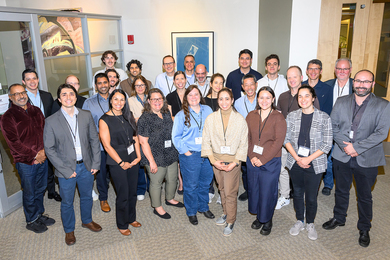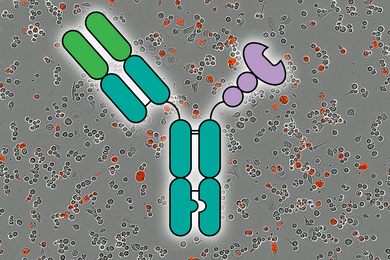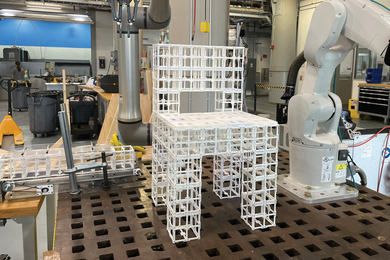CAMBRIDGE, Mass. --The U.S. Food & Drug Administration (FDA) yesterday (April 13) gave a company founded by a Massachusetts Institute of Technology researcher the go-ahead to market a test that can accurately predict the risk of dying suddenly from a wildly irregular heartbeat. Sudden cardiac death is the nation's leading cause of death, killing around 350,000 people each year.
The noninvasive test, which predicts sudden cardiac arrest caused by an electrical malfunction of the heart rhythm, could change the way physicians treat patients with cardiac problems. Because the test is as accurate as more risky, costly procedures, it could be used by many more patients, says Dr. Richard J. Cohen, MD, PhD, inventor of the test and a professor at the Harvard-MIT Division of Health Sciences and Technology.
While sudden death is more frequent in older individuals, in some cases -- like that of Reggie Lewis of the Boston Celtics -- the victim is young and apparently in good health. Using Dr. Cohen's test to screen patients with syncope -- the unexplained fainting that affected Lewis before his death -- is just one way the test could be used to identify high-risk patients and save lives.
"From a clinical perspective, the challenge is to look at the group of people who might be at risk for sudden death and determine who is really at risk and would benefit from therapy," said Dr. Cohen, whose laboratory created a computer-based system that can detect tiny electrical changes in the beat-to-beat fluctuations of the heart.
LETHAL IRREGULARITIES
Ventricular tachycardia and ventricular fibrillation are two of the most serious types of arrythmia.These arrythmias affect the heart's ventricles, or main pumping chambers. In ventricular tachycardia, the ventricles beat too fast, compromising their ability to pump blood. Ventricular tachycardia may turn into ventricular fibrillation.
In ventricular fibrillation, the ventricles contract in a disorganized fashion that results in total loss of their blood-pumping action.Ventricular fibrillation, unless halted by an electrical shock, is uniformly fatal and is the immediate cause of sudden death in the vast majority of cases.
Sudden death from ventricular arrythmias occurs most commonly in patients who have underlying heart disease. For example, heart attacks, caused by diseased blood vessels in the heart, may leave patients more prone to sudden cardiac death. Those who have suffered a heart attack have a 35 percent chance of dying from sudden cardiac death.
The 5 million Americans with congestive heart failure are at particularly high risk of sudden death. Approximately one in 13 of these patients will die within a single year from sudden death.
Dr. Cohen's diagnostic tool detects a subtle electrical warning signal recorded by high-resolution electrodes while the patient exercises on a treadmill or stationary bike. The so-called alternans test measures T-wave alternans, a change from one heartbeat to the next that is so small it would never show up on a standard electrocardiogram. "We're looking for a 1-microvolt change, or approximately 1-millionth of the voltage on a standard flashlight battery," Dr. Cohen said. Patients with the tiny change called T-wave alternans are at much greater risk of ventricular arrythmias and sudden death than those without it.
WHO'S AT RISK?
Up to one third of individuals who will die of sudden cardiac death do not even know that they have heart disease. Others may have known heart problems but are not considered to be at risk of sudden death.
In many cases, sudden death may be prevented by an implantable cardioverter defibrillator, a device that detects when the heart goes into ventricular tachycardia or fibrillation and ends the arrythmia by applying electrical shocks to the heart.
The problem is that doctors don't know which patients are at greatest risk. An implantable defibrillator, including doctor and hospital fees associated with the implantation and subsequent monitoring of the device, can cost more than $50,000. "So the real question is, how do you decide who needs a defibrillator?" Dr. Cohen said.
In a clinical study conducted in collaboration with Dr. Jeremy Ruskin of the Massachusetts General Hospital, the tiny telltale sign of T-wave alternans proved to be as accurate as predicting risk as an invasive test called electrophysiological testing, a costly and somewhat risky procedure that requires introducing a catheter into the heart to deliberately induce ventricular arrhythmias.
In high-risk patients undergoing electrophysiological testing as part of their clinical care, 81 percent of patients in whom alternans was detected subsequently had a life-threatening venticular arrythmia or sudden death.
Only 6 percent of those without electrical alternans were similarly affected. In this study, T-wave alternans was measured while a pacemaker was used to control the heart rate.
DEVELOPING THE TEST
Five years ago, the technology to detect T-wave alternans was licensed to a company Dr. Cohen helped found, Cambridge Heart, Inc. (NASDAQ/NMS:CAMH) of Bedford, MA, which received FDA approval to use the technique and to continue to compare its results with those of invasive tests.
The company's challenge was to come up with a way to gather very precise data on a patient's heartbeat without a pacemaker in place. They came up with high-resolution electrodes that reduce background "noise" in the signal. Using these electrodes makes it possible to perform the test during bicycle or treadmill exercise.
To the patient, the test is essentially no different from a standard stress test. "From the patient's perspective, this is a simple and straightforward test," Dr. Cohen said.
Cambridge Heart recently completed a multi-center study that found that patients with T-wave alternans were 11 times more likely to have a life-threatening ventricular arrythmia or sudden death than patients without T-wave alternans.
AN ELECTRICAL CLUE
Although electrical alternans has been known to exist for 90 years, reports linking the presence or absence of alternans with sudden death in heart patients were largely anecdotal. In the past, alternans could only be detected on the rare occasion when it was so large that it could be seen on a standard electrocardiogram. There was no means to measure alternans at a microvolt level.
Dr. Cohen says that recent animal and computer studies suggest that when electrical activity in the heart alternates every other beat, this causes electrical wavefronts to break up and recirculate, causing ventricular tachycardia and fibrillation.
Thus, T-wave alternans may directly measure the cause -- not just a symptom -- of ventricular arrythmias and sudden death.
PICTURING THE HEART
Dr. Cohen applies physics, mathematics, engineering and computer science to problems in medicine and health. Other research efforts in his lab include noninvasive detection of coronary artery disease, noninvasive assessment of cardiovascular regulation, effects of aging and diabetes on the cardiovascular system, effects of space flight on the cardiovascular system, treatment of heart rhythm disturbances and ultrasound imaging of the cardiovascular system.
Meanwhile, he is working on other non-invasive, inexpensive tests that would offer physicians a wealth of information without a lot of trouble and expense for the patient. One such test would provide an image of the heart, pinpointing which heart-muscle regions are losing blood because of arterial blockages.
Dr. Cohen's work has been supported by NASA, the National Science Foundation, the National Institutes of Health and the Department of Defense. NASA, through its National Space Biomedical Research Institute, is sponsoring the use of T-wave alternans to determine whether space flight increases the risk of heart rhythm disturbances.
"Support of this work by NASA and the Department of Defense demonstrates the important spin-off benefits to civilian medicine from aerospace medicine research," Dr. Cohen said.





